“We had a lengthy debate about that and I encouraged her to do a little bit of research on color of law and direct and constructive notice, but, I did not bring up entrapment,” Poe said. “And, this is clearly a case of entrapment. She gave us permission to access our real property mining claim—which we actually didn’t need—and then encouraged us … with the intent of criminal prosecution.”
Brad Jones
The fight for mining rights on public lands in the western Mojave Desert is heating up once again.
In an alleged attempt to illegally block small-scale gold miners from accessing their mining claims, the Bureau of Land Management has erected “ROUTE CLOSED” signs near Barstow, Calif.
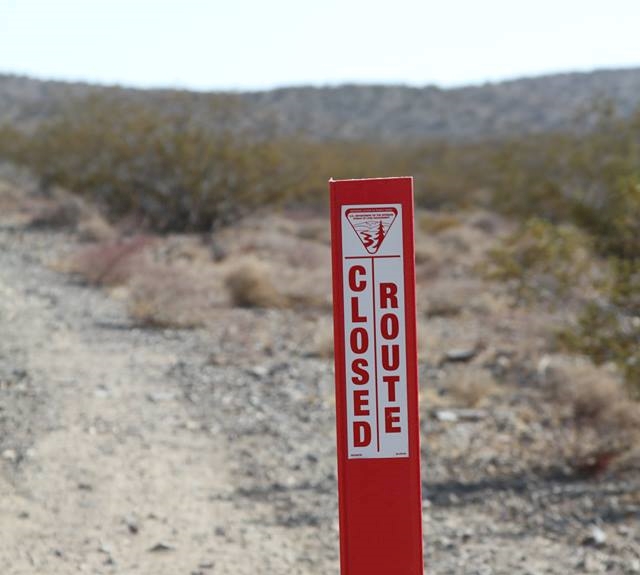
Two Southern California gold prospecting clubs, the Route 66 Gold Miners and the Temecula Valley Prospectors began planning an outing on two Route 66 mining claims near Barstow last June. The event was announced at the end of August and set for mid-October.
But near the end of September, the American Mining Rights Association received word that the Bureau of Land Management had posted signs blocking access to the mining claims.
AMRA President Shannon Poe caught wind of the BLM scheme when a miner trying to access the claim sent him a photograph of the red route closed marker posted in the middle of the road.
“It was the very road we were planning to use to access two mining claims that Route 66 Gold Prospectors owns,” Poe said. “We were opening them up to hundreds of miners who were going to come to the outing.”
Under the Mining Law of 1872 as amended, blocking access to an active mining claim is illegal.
“I made one phone call really quickly to the BLM office in Barstow and spoke to a guy by the name of Jeff Childers,” Poe said. “And Childers, while he presented himself as the manager of the BLM office, was not … but he told me that they put the signs in the roads there and that the roads were now closed as part of the WEMO Plan.”
WEMO, or the West Mojave Plan is a BLM Travel and Transportation Management plan covering 9.24 million acres in the West Mojave area of the California desert, of which 3.1 million acres are public lands managed by the BLM.
The 2006 West Mojave Plan is supplemented by the West Mojave Route Network Project, or WMRNP, and covers the western portion of the Mojave Desert, including parts of San Bernardino, Los Angeles, Kern, Inyo, and a small portion of Riverside Counties. The plan applies to public lands in the planning area, and the travel management strategies apply on lands that are available for motorized and mechanized travel on designated routes only, totaling about 2.35 million acres. The plan is designed to protect critical desert habitat.
Calling out the BLM
According to Poe, he and Childers engaged in a lengthy, but cordial phone conversation.
“Childers kept bringing up the desert tortoise. He said they had transferred a bunch of desert tortoises in that area, which I later found out was to the south of there and it wasn’t specifically where these mining claims are although I was led to believe, initially, that it did,” Poe said. “So, I explained to Mr. Childers in a rather lengthy—probably a 45-minute call—that they cannot lock and block mining claim owners for a variety of reasons, the first being the Americans with Disabilities Act. Making a 70-year-old man with a fake knee and a fake hip pack in and walk two miles through the Mojave Desert to access his mining claim isn’t just immoral; it is illegal under the ADA as well as under the RS 2477 or Revised Statue 2477 law which states that all roads prior to 1976 must remain open.”

In 1976, Congress passed the Federal Land Policy and Management Act, or FLPMA, which governs the way in which public lands administered by the BLM are managed. Land uses include commercial uses such as livestock grazing, mineral extraction and logging; and recreational uses such as fishing, hunting, birding, boating, hiking, biking, and off-roading. They also include conservation of biological, archeological, historical, and cultural resources. The BLM manages about 261 million acres of public lands, comprising about 12 percent of the United States.
When Childers disagreed with Poe’s assessment of the situation and interpretation of the law, Poe informed Childers that he would provide him with documentation in the United States v. Steve A. Hicks case.
In the Hicks case, the U.S. Court of Appeals, Ninth Circuit, ruled that Hicks, an employee of a mining company which owned mineral rights in a Montana national forest, was not subjected to a Forest Service road closure order which exempted landowners.
“The U.S. Forest Service had cited Hicks for driving in and accessing his mining claim,’ Poe said. “And, it was found that mining claims are real property in every sense of the word.”
According to Poe, Childers claimed that the BLM answers to the executive branch and not the judicial branch of the federal government.
“His reply back to me was that the Supreme Court decisions did not apply to him or the BLM,” Poe said. “He said that the very first time I called him on the Thursday two weeks before the outing and I had a witness.”
Childers agreed to review the Hicks case documents that Poe would later send to him and then discuss the matter further.
“That was on a Thursday. He said he would get back to me either the next day or by Monday afternoon,” Poe said. “Monday came and I got no response. Tuesday I sent him an email and I called his office and left him a message. Wednesday—same thing—called, emailed, no response. So, on Thursday, I called and asked for the manager in charge of the entire BLM office, and I got Katrina Symons. And, this time, I verified that she was the field manager of the Barstow District Office.”
Childers is listed as Assistant Field Manager in BLM documents.
BLM chain of command
Symons told Poe that she was aware of the road closure issue and had discussed it with Childers. That’s when Poe began to press her for an answer on whether the roads would be open for the outing in mid-October, he said.
“My discussions with Katrina Symons were very frequent and robust, although we were both very professional and I applaud her … for the professionalism,” Poe said. “She never raised her voice and never interrupted me. They were very polite and professional conversations.”
Nevertheless, Symons insisted that is was within the bounds of her authority to close the roads to the miners, said Poe.
“I said, ‘Well, you may under certain circumstances, but these people aren’t mere guests or recreationalists; they own real property.’ ”
“After a week’s worth of conversations, she agreed to give me a definitive answer … two days before the outing,” Poe said. “She finally called and said she wasn’t going to restrict our access to the mining claims for the weekend. She asked us to please tell our people about the desert tortoise and how to protect the species.”
Poe said he was only too willing to comply with Symons’ request since AMRA and other gold prospecting clubs already pride themselves in respect for nature and wildlife, as well as responsible stewardship of the land. And, he asked Symons if she had any literature on the tortoises that he could hand out to prospectors at the outing.
Symons agreed to meet Poe at his campsite at the Slash X Ranch on Friday, Oct. 13, preceding the outing. When Symons arrived about 5:30 p.m., she met with Poe and two senior members of the AMRA board of directors, Jere and Connie Clements, at a picnic table.
“She had Jeff Childers with her and we talked for about 15 minutes about the desert tortoise and how we could protect them — just common sense stuff, and she had a big stack of pamphlets,’ Poe said.
According to Poe, Symons said the BLM would go a step further and check the roads the miners planned to use for tortoises on the Saturday morning of the outing.
“I said, ‘Great. We’ll be out there at 9 o’clock. That’s fantastic! We’ll wait until you guys clear the road, and then we’ll go in.’ ”
Problem solved. Or, so he thought.
The plot thickens
Then, in a shocking turn of events according to Poe, Symons threatened Poe with criminal prosecution, adding she would take photos of his vehicle and license plate once he had driven past the BLM road closure signs.
Poe then asked Symons to explain her sudden about-face change in position, he said.
“She said: ‘I’m going to take picture of your truck, fill out an affidavit and send it to our law enforcement division for criminal prosecution,’ ” Poe said.
“So, I said: ‘Last night, Katrina, you told me on the phone—and I have a witness—that you were going to give us unrestricted access,’ ” Poe said.
Symons reaffirmed that while she wouldn’t prevent the miners from accessing the claim, that she was would pursue prosecution, according to Poe.
Entrapment?
“We had a lengthy debate about that and I encouraged her to do a little bit of research on color of law and direct and constructive notice, but, I did not bring up entrapment,” Poe said. “And, this is clearly a case of entrapment. She gave us permission to access our real property mining claim—which we actually didn’t need—and then encouraged us … with the intent of criminal prosecution.”
Although AMRA pointed out that as a BLM district field manager, Symons has the authority to open the roads, but she denied having this power even though it is clearly stated in the WEMO plan, according to Poe.
“It’s stated right there in black-and-white in the WEMO plan that she has the discretion to open the roads,” Poe said. “She disagreed with her own management plan, and I challenged her. ”
He also challenged Childers’ earlier claim that the BLM does not have to abide by Supreme Court decisions in front of Symons and Childers back-pedaled, Poe said.
Rule of Law
Before the meeting with BLM, Poe had contacted San Bernardino County Supervisor James Ramos and Captain Manny Mendoza of the San Bernardino Sheriff’s Department to inform them of the situation, Poe said.
Both the county and the Sheriff’s Department supported the miners’ right of access to their claims, he said.
The Sheriff’s Department told Poe that it would provide support if needed, but because Symons had previously said she would allow miners access to their claims, Poe had called off the dogs, so to speak.
“That was before I knew she was going to do a 180,” Poe said.
BLM no show at outing
According to Poe, Symons said BLM staff would come out and walk the roads to check for desert tortoise the Saturday morning of the outing. But, when dawn arrived and there was no sign of the BLM.
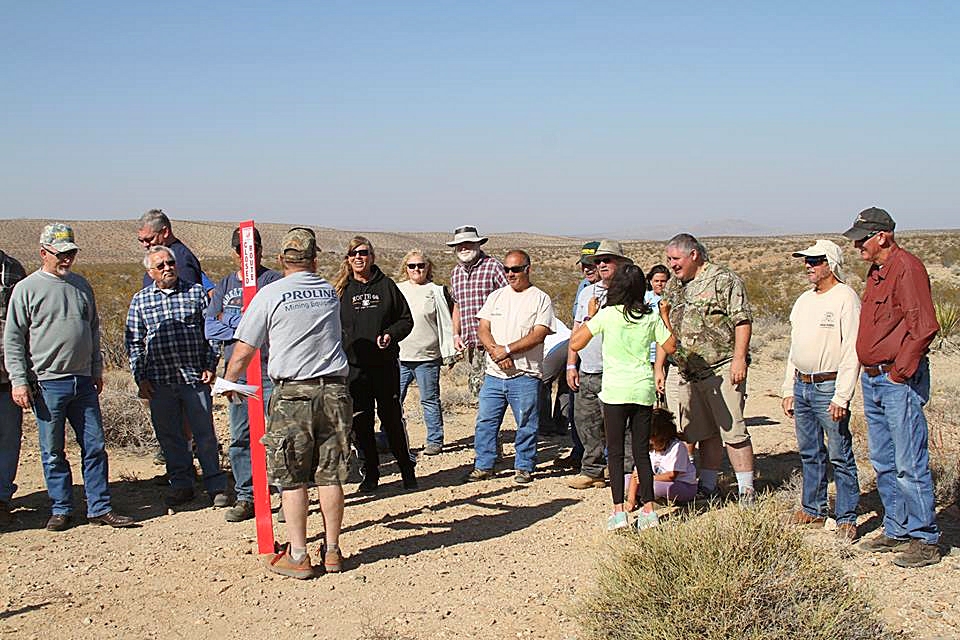
“Instead, the miners themselves walked the roads themselves to check for signs of the desert tortoise. None were found,” Poe said.
Then, the miners did what miners do. They drove to the their claims, but not before AMRA board member Reb Baraglia handed out brochures on the desert tortoise.
Poe made a point of asking all miners to keep an eye out for the lowly desert creatures and, if spotted, to leave them undisturbed.
“Nine o’clock the next morning rolls around and the BLM was nowhere to be found,” Poe said. “We actually walked two of the roads that were going to be used to access the mining claims, and then we drove in. We filmed the entire thing to make sure no desert tortoises would be hurt. I don’t know what happened, but apparently the BLM didn’t think the desert tortoise deserved their attention. So, maybe that was just a facade.”
BLM’s position
In a phone interview, Monday, Nov. 27, Symons dismissed Poe’s version of events, stating that she has never told Poe she would allow access on a closed route to the mining claims.
“At no time did I say I was going to allow access on a closed route without going through the process,” Symons said.
When asked to respond to Poe’s specific complaints against the BLM, Symons referred to an official letter stamped Oct. 6, 2017 that she had emailed to Poe requesting more information about the specific route and mining claims that he wanted to access.
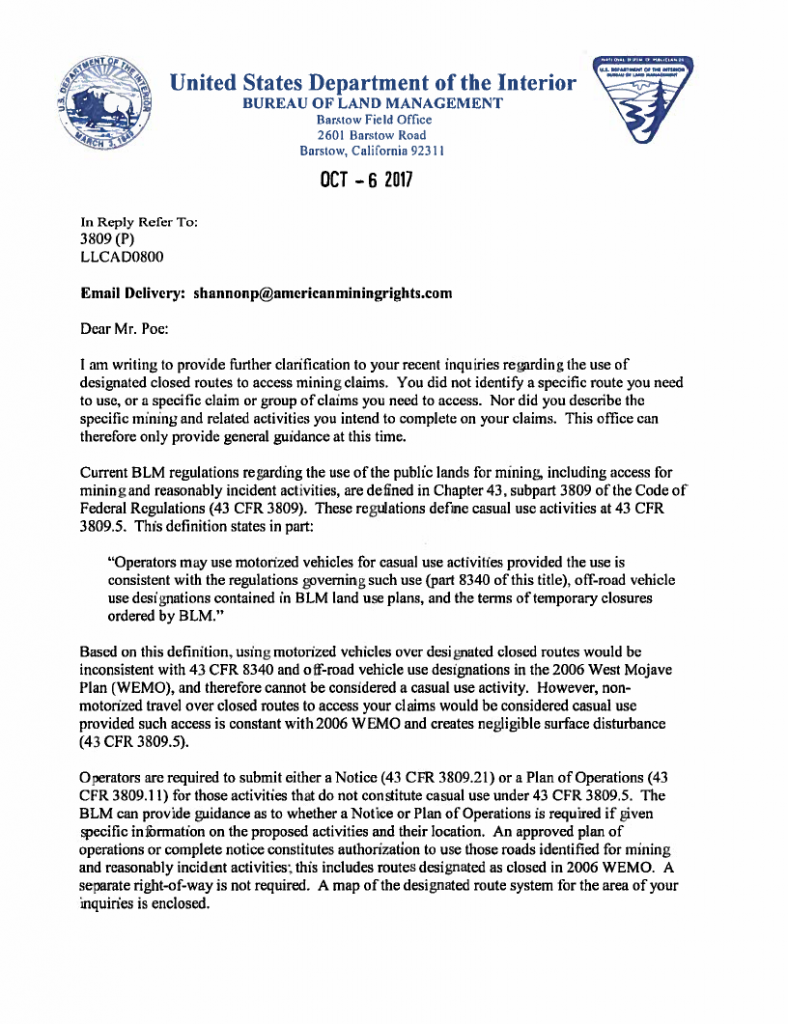

“BLM certainly doesn’t what to get into a “he said, she said,” Symons said. “And, that is the reason why I put the request I had from Mr. Poe into a letter. I certainly would want to formalize a response because whenever you talk it goes through filters and I would rather have something in black-and-white in order to be able to respond.”
However, Symons explained the situation from her point of view.
“We had originally been contacted, or my office had been originally contacted, by Shannon Poe concerning the placement of red route closed markers within that particular subregion. And so, this office responded that the red route closed markers are basically the first step we take in route restoration. Then, we went on to explain that back in 2006 we issued the West Mohave decision which basically confirmed which of the routes within the planning area … were open to OHV use and which ones were closed.”
Symons went on to explain that not all closed routes are marked as closed.
“Basically, if a route is not signed as being open, which would mean it would have a brown paddle with a letter designator and usually two to four numbers with it, then it’s closed,” she said. “ If it’s not signed open, it’s closed.”
The main reason miners were not given access to their mining claims is because, according to Symons, the information Poe provided was not specific enough.
“That is where we’ve got a little miscommunication … We were not given specific points on the map or routes that they wanted to use,” she said. “I issued a letter to Mr. Poe specifically requesting information and exactly the information I needed so that we could apply the mining law and the mining regulations in order to go through the proper process of providing access, and it’s that information that Mr. Poe has yet to provide my office.”
The first paragraph of the letter signed by Symons on official BLM letterhead reads: “I am writing to provide further clarification to your recent inquiries regarding the use of designated closed routes to access mining claims. You did not identify a specific route you need to use, or a specific claim or group of claims you need to access. Nor did you describe the specific mining and related activities you intend to complete of your claims. This office can therefore only provide general guidance at this time.”
The letter then goes on to list several BLM mining regulations, and states that motorized vehicles are not permitted on any designated closed routes.
But, the written correspondence doesn’t tell the whole story of what happened about a week after the letter was stamped and emailed to him, Poe said.
The face-to-face meeting
Symons confirmed that she and Childers met with Poe on Friday, Oct. 13, at Poe’s campsite but disagreed with Poe’s account of what was said. She contends that Poe did not inform her or the BLM office of which specific routes or mining claims the miners were planning to access.
“On that Friday, we met with him expecting to get the information … and we did not get that information,” Symons said.
However, Poe claims that Symons was informed that the miners had planned to access two specific mining claims, the Yellow Bird and the High 5 claims, which are marked on BLM maps.
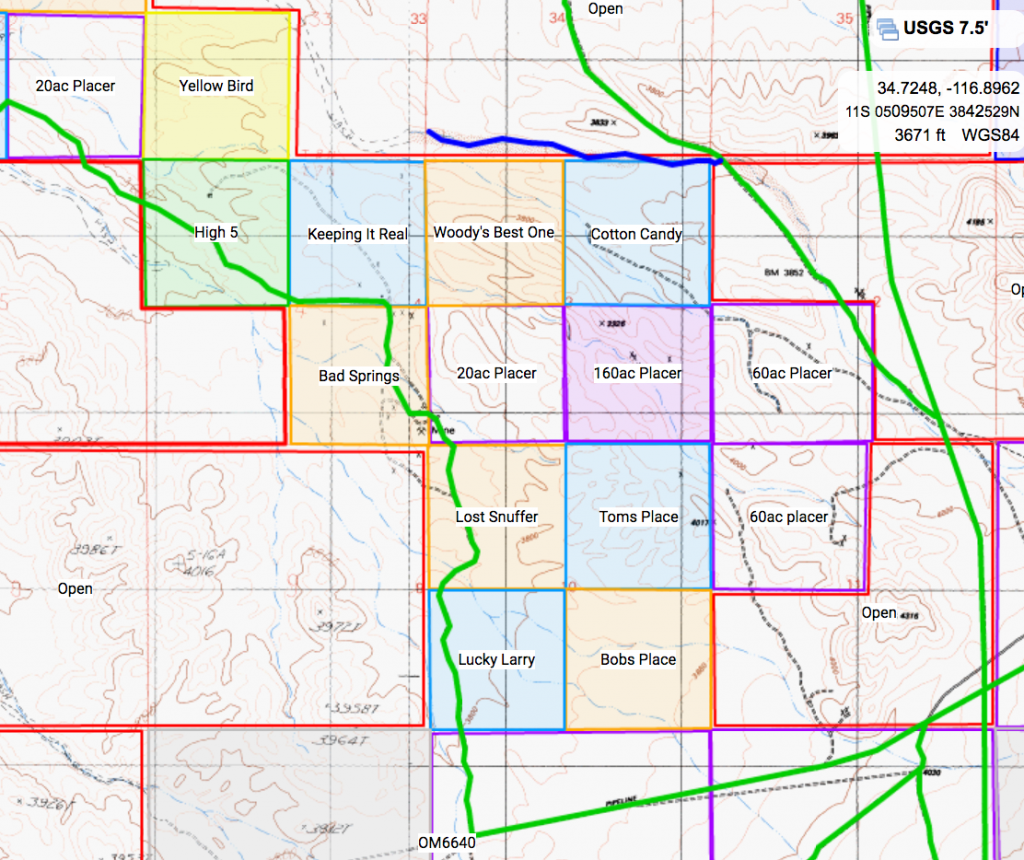
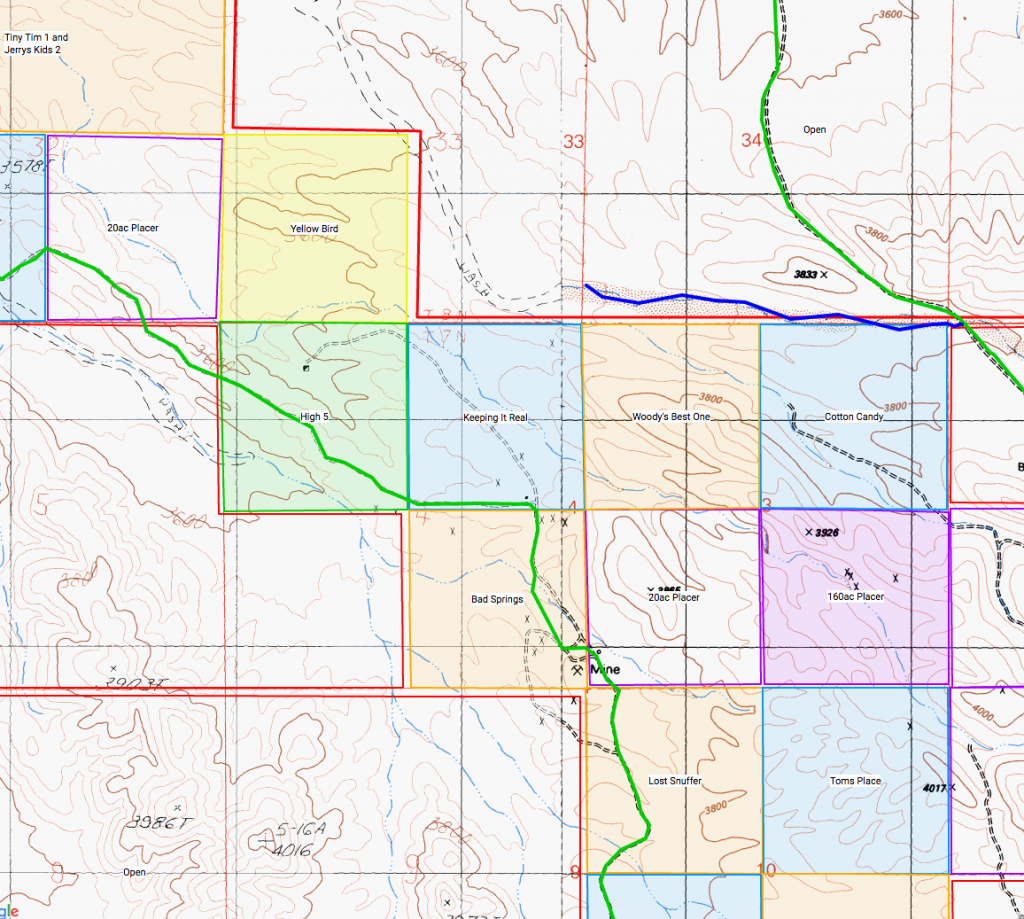
“We did get a map that was of a very large area that had multiple mining claims on it, but then I was told on that Friday they could be on any of that area during that event,” Symons said. “I was not given specifics.”
Casual use
The letter states that using a motorized vehicle on a designated closed route is not considered “casual use” under BLM regulations. The document also suggests that an official Notice of Intent and Plan of Operation is required to obtain legal access to the mining claims.
“Miners need to follow our surveyed ’09 regulations and our Travel and Transportation Management plans,” Symons explained. “And, in this particular case, if it’s a mining claim and they need access, then they need to come to BLM and provide documentation whether it is a Notice [of Intent] or a Plan Of Operation—so what they are planning on doing and what reasonable access they need in order to access the mining claim. That was part of the letter that I sent to him so that BLM could follow the process to provide for access.”
But Poe argues that miners have a right to drive vehicles to their mining claims under the law and that accessing the claim has nothing to do with whether the actual prospecting activities are casual use or not. He contends that the miners are not hauling in heavy equipment or machinery, but rather portable drywashers, picks and shovels, which he says constitutes casual use.
Symons said the issue of casual use and whether or not Notice of Intent or Plan of Operation is needed is where she and Poe reached “a point of agreeing to disagree.”
“The problem with Mr. Poe is there is just a disagreement on the application of law and regulation,” Symons said.”
United States v. Steven A. Hicks
When it comes to which court rulings apply, and Poe’s reference to the United States v. Steve A. Hicks, there appears to be even more confusion.
“Well, I believe that Mr. Poe misunderstood,” said Symons. “Because, as I understand it, Mr. Poe had sent Mr. Childers a Utah Supreme Court ruling. Mr. Childers had informed him that it was basically a state ruling; it’s not federal—and that BLM will and does comply with the 1872 Mining Law and the associated mining regulations. So, I think that was more of a miscommunication or misunderstanding.”
In a follow-up interview Dec. 1, Poe responded that the Utah case involving RS 2477 laws on rights-of-way and the Hicks case are two separate cases, and that the United States v. Steve A. Hicks case is obviously federal.
Are mining rights eroding?
Though tensions have been mounting among land-user groups and environmental groups on public lands across the western United States for decades, Symons said the BLM maintains its position is to accommodate miners as well as other land-use groups.
“BLM wants to support mining. We are a multiple-use agency,” she said.
When pressed about the increasing friction between miners and the BLM, she denied there is any animosity.
“No, no, no,” Symons said. “The BLM—we are a multiple-use agency. We are supportive of multiple uses on the grounds. I’m working with miners every day in order to get the mining taking place, just like I’m working with folks for rights of way, for grazing, for OHV use. I don’t agree … that BLM is not supportive because we are. It’s just that at BLM we’ve got our laws, regulations and polices and I just need to make sure I follow them. What I do for one, I do for all, and we’ve got to treat everybody fairly and equally and in accordance with the law.”
Yet, clearly miners are facing more bureaucracy and restrictions from government agencies, which are being pressured from environmental lobby groups, according to mining rights groups, such as AMRA.
BLM policy under review
For the past several years the BLM has been under court order to re-evaluate route closures on public lands in the WEMO planning area.
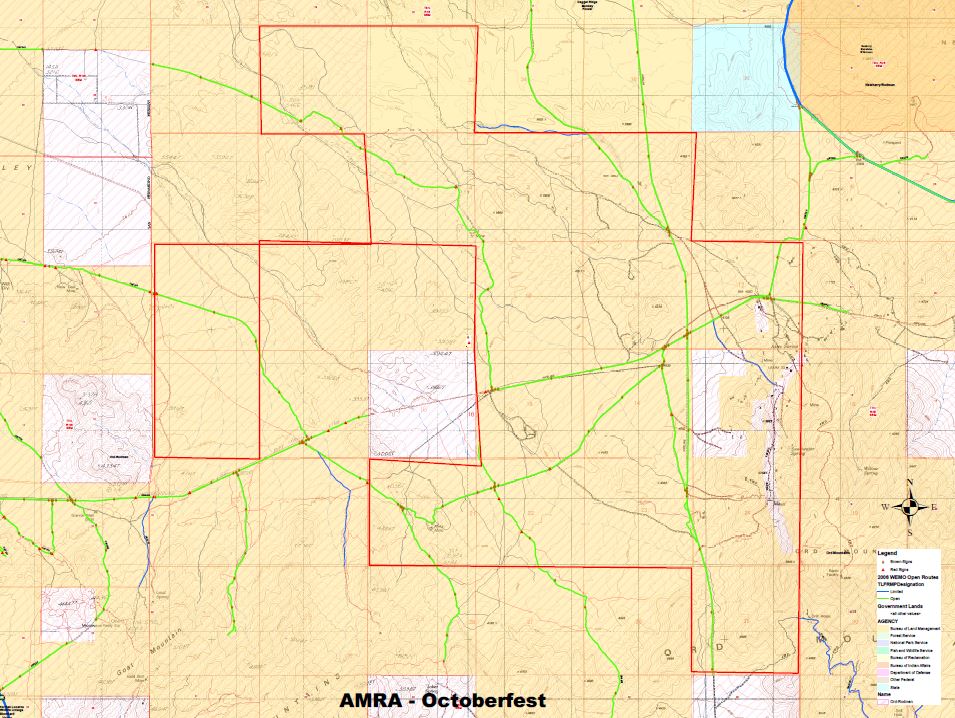
“Right now BLM is involved in a lawsuit and court order,” Symons said. “So, we are redoing the environmental analysis for the 2006 West Mohave decision … called the West Mohave Route Network Project. And, we are reconsidering which routes are to be open and which routes are to be closed.”
The new Supplemental Environmental Impact Statement is due to be issued in January of 2018 with a final decision to be issued in October of 2019.
In January, 2011 United States District Judge court judge Susan Illston ruled that the BLM had violated the National Environmental Policy Act and FLPMA in adopting the March 2006 WEMO management plan. The court decision stemmed from a lawsuit filed by the Center of Biological Diversity, an environmental group that has a long history of friendly lawsuits against the BLM and other government agencies according to the “Sue and Setttle: Regulating Behind Closed Doors” report issued by the U.S. Chamber of Commerce in May, 2013.
On Sept. 28, 2009 the court held that the “decision tree” the BLM had used to designate Off-Highway Vehicle routes was flawed because it did not comply with regulations mandating that the BLM consider various “minimization criteria” when designating OHV routes.
Because the WEMO plan authorized numerous OHV routes that were not in existence in 1980, the plan is inconsistent with the governing land-use plan which limits OHV routes to those existing in 1980.
In order to comply with the court ruling, BLM must explain why certain roads were closed and others were left open, Symons said.
“There are what we call minimization criteria,” Symons said. “The court found fault in the manner in which BLM designated routes, and that’s what this new environmental document is intended to address. It’s basically a relook at our transportation system.”
‘Restoration’ and ‘rewilding’
Destroying roads and trails to the backcountry has been going on for years, if not decades, under FLPMA travel management plans. The term for obliterating existing roads and trails, at least in some circles of the environmental movement, is “rewilding,” but the BLM has another name for it.
“We call it restoration,” Symons said. “That’s the final step. It’s the most expensive step that one can take, so our first step to restoration is putting up a red route closed sign. It works about 50 percent of the time.”
If the BLM finds that the route closed signs aren’t effective in deterring people from driving on closed routes, the next step is to create more imposing roadblocks, Symons said.
“Then, for those areas where that first step to restoration isn’t working, we go to other steps, such as putting up barriers,” said Symons,.
The barriers can range from posts-and-cables to other types of fencing or placing large boulders in the a road to physically block vehicular access.
“Then, if that doesn’t work, we go and invest more money into it by doing vertical and horizontal mulching, basically obliterating the visual representation of what had been that former route,” Symons said.
Poe counters BLM argument
“In a follow-up interview Dec. 2, Poe accused Symons of “bald-faced lies,” and countered her argument that AMRA had failed to submit specific information needed about the mining claims and the routes miners planned to access for the outing.
“We absolutely did provide her and the BLM office with the specific information of both the Yellow Bird and High 5 mining claims and the route needed to access those claims,” Poe said.
Legal action?
A few weeks ago, Poe also sent Symons a video of him and other miners driving beyond the route closed markers and accessing their mining claims.
When asked if she had seen the video of Poe’s defiance, Symons replied that she was behind on her mail and had not seen the video.
In response to Poe’s allegation that Symons had said she would not restrict access, but then threatened to report him to law enforcement, Symons said that Poe wants to be cited so that AMRA can fight the BLM in court.
“Mr. Poe had made a statement to me that he wanted to make a test case … so that this could go to court and a ruling could be made concerning whether or not he was within his rights to drive down a closed route,” Symons said. “I said if he wanted to make this a test case, then I could be there when he drove down the closed route. I could then provide the information to law enforcement … but Mr. Poe never followed up on that. On that Friday night, he did not provide me with information as to the routes—the closed routes supposedly—that they wanted to use to access the mining claims, so I wasn’t out there.”
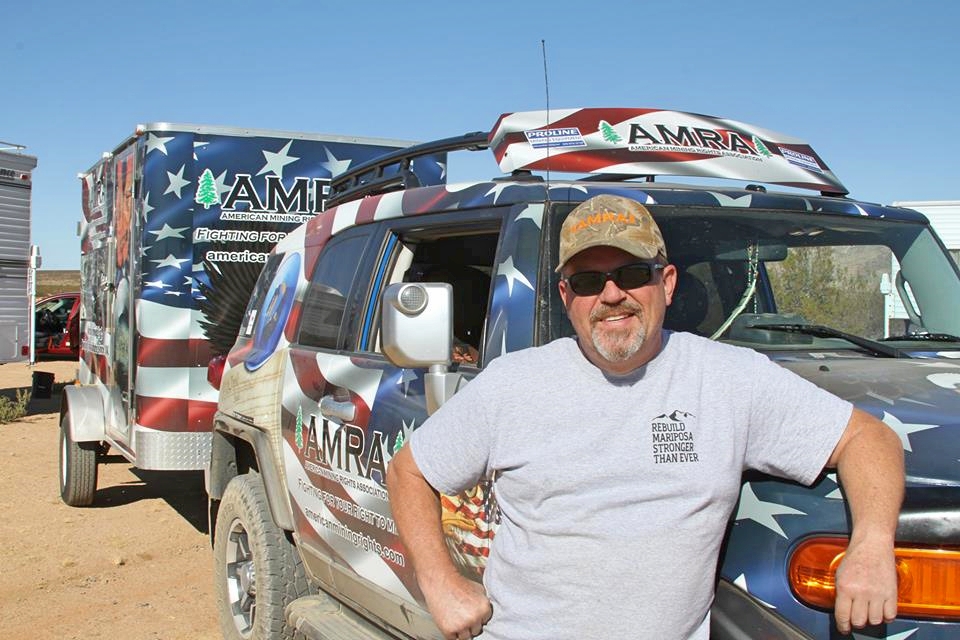
Photo courtesy of Brad Jones
Symons said on Nov. 21 that because she hadn’t seen any evidence of Poe breaking the law, she has not notified law enforcement.
“There’s no action to take,” she said. “I can tell you right now that I have not seen a video, so I have not taken any action.”
Symons would not say for sure what action, if any, would be taken if she does watch the video of Poe driving on a designated closed route.
“If there was activities that were not authorized, my standard operating procedure is to hand it over to law enforcement,” she said. “The process that I would use is that I would forward it to law enforcement. After that, it’s outside my hands. I don’t have any say over what law enforcement does or doesn’t do.”
The miners
About 200 miners showed up at the event, proceeded past the route closed signs and enjoyed the next few days gold prospecting on the Yellow Bird and High 5 mining claims.
“The miners united and said ‘We’re not going to take this anymore’ and really stood up to the BLM,” Poe said. “Here is the jackboot of the government stomping on the little guy, and the little guy stands up and says, ‘Back off!’ ”
Bruce Sherman of Riverside, Calif. was on hand to show his support for AMRA and do a little prospecting for gold.
“When there is a road with two tire tracks that have been here for years and years, I think it’s just ridiculous that the BLM is even bothering with them …” he said. “The claims have been here for a hundred years. The BLM is not using common sense,” Sherman said.
Sherman has been mining off and on since the 1970s.
“I love the desert, and I like to get out here,” he said. “Miners are cautious about what they’re doing and pretty conscientious about it, too.”
Another miner, Dave Van Selow of Downie, Calif., said he signed up for the outing mainly to support AMRA’s effort to keep roads open on public lands.
“The BLM, U.S. Forest Service and other government agencies have been doing a ‘pretty good job’ of closing roads and denying access to mining claims,” Van Selow said with more than just a hint of sarcasm.
“AMRA seems to be the organization that’s doing the most good for public land users … Shannon’s doing a great job.”
Rod Hall, a member of the Temecula Valley Prospectors and AMRA, concurred.
“As far as I’m concerned, this is open desert. It’s open to miners. And, that’s what we are—small miners,” said Hall. “We are not recreationalists. We are miners and we’re here to find gold and enjoy the outdoors.”
Pointing to some of the portable drywashing equipment miners were using that day, he said the BLM was wrong-headed to close roads and force miners to pack in small-scale mining equipment by foot.
“I think AMRA is doing a wonderful job confronting the BLM,” Hall said.
“If that road was closed and we couldn’t drive in, I couldn’t get out here. I’m permanently handicapped and I could not walk my equipment back here. I’ve got a knee replacement and a plate in my back. I can’t carry equipment for two miles or a quarter-mile,” Hall said. “This is a family event for us. I have my sister … and her two kids—my niece and nephew, and we have one young lady who is in a wheelchair … so it restricts us if these roads are closed.”
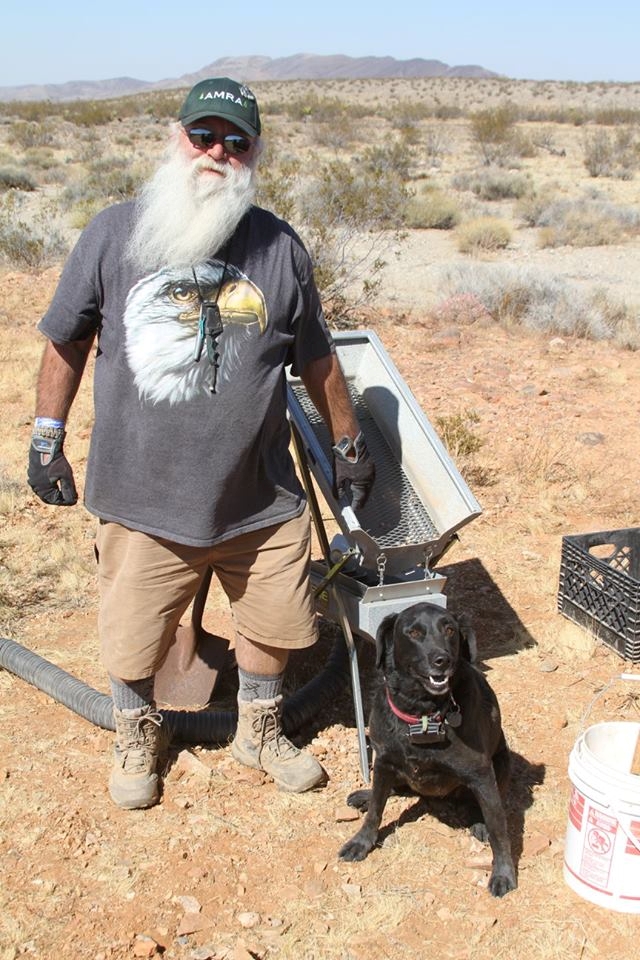
AMRA Public Affairs Officer Jeff Baraglia said he is disappointed with the BLM’s treatment of miners.
“You know, this our fundamental right as miners to access our claims, and the BLM is closing roads without public input,” Baraglia said. “We just can’t let that stand.”
He called on all miners to support AMRA’s efforts to fight against unnecessary government overreach.
“Supposedly there are desert tortoises are out here. Nobody wants to hurt a desert tortoise or any other animal,” especially the mining community. “I’ve been mining out in the desert for 11 years now, and I’ve never seen one. But, if I did, I wouldn’t touch it; I wouldn’t move it and I wouldn’t feed it … just let it live on its own and do its own thing.”
Baraglia said he likes to get outdoors with his family to camp, hunt, fish and prospect for gold. He finds it a nice reprieve from trappings of the city including electronics and devices
“Earth is here for us to enjoy and that’s what we do,” he said. “And, we’re doing it the way we like to do it.”
Bureau of Land Management
It is stated on the BLM website that mining and minerals are an important land use supported by the federal government:
Mining and Minerals
Mineral development is an important land use within the BLM’s multiple-use mandate. In communities across the country, mining provides jobs, economic activity and important commodities that are essential to maintain a high quality of life.
Link: https://www.blm.gov/programs/energy-and-minerals/mining-and-minerals.
Watch the video
BLM Barstow Field Office
Katrina Symons, Field Manager
2601 Barstow Road
Barstow, CA 92311
Phone: (760) 252-6000
Email: BLM_CA_Web_BA@blm.gov
BLM website: www.blm.gov
AMRA
AMRA President Shannon Poe
www.AmericanMiningRights.com
PMB #607, 6386 Greeley Hill Rd.
Coulterville, CA 95311
Phone: (209) 878-3910
Email: support@americanminingrights.com
Brad Jones is a freelance journalist based in Southern California. He can be reached at AmericanLibertyPost@gmail.com.
[paypal_donation_button]
Free Range Report
[wp_ad_camp_3] [wp_ad_camp_3] [wp_ad_camp_3]
[wp_ad_camp_2]
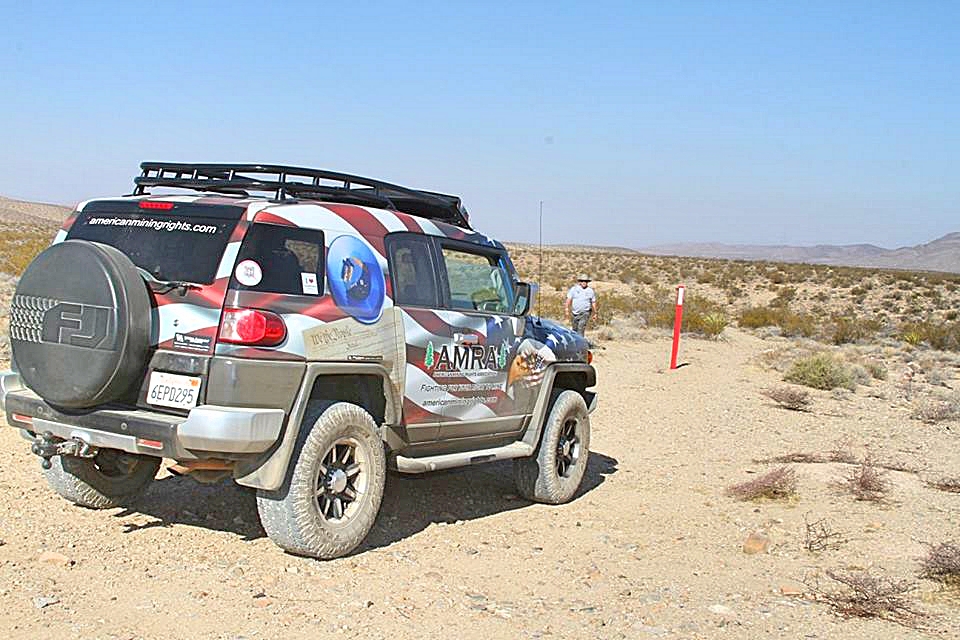

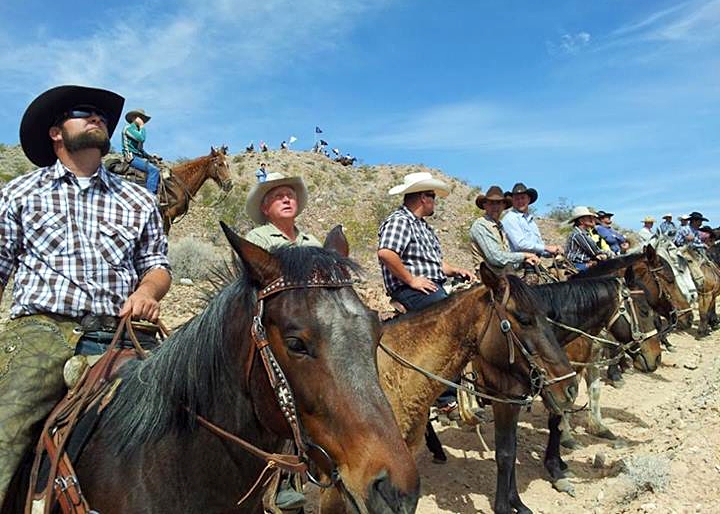

Thank you for publishing this Ms. Haun. Small miners too often are forgotten and ignored. There are so many lies in her statement here, I’m glad it is preserved for prosperity.
We sure appreciate this.
Shannon Poe, President, AMRA
The article is very detailed and correct on the point presented but leaves out one essential issue and that is the date the mining claims were established determines the nature of the easement that contains the road. Apparently the mining claims predate Federal Land Policy and Management Act of 1976. If so the author could also have discussed the nature of easements established under the mining laws prior to FLPMA which are protected by FLPMA. The easements are protected as existing rights in most federal laws and for example the Savings Clause of FLPMA is found 43 USC 1701 (h) (aka Title VII Section 701) and states: “(h) All actions by the Secretary concerned under this Act shall be subject to valid existing rights. ” Congress recognized that the private rights existed on the federally controlled lands in just about every federal statute including this one.
I would suggest that the road is not the issue so much as the easement and that easement was originally established for private access to private rights claims of property held in equity. In other words the easement exists and is at least 100 feet wide and further has a road somewhere within the easement not just at the location it currently occupies. The use of the road may also have established a public easement under RS2477 but that is simply overlying the original private rights.
Courts have held that the federal officials may enforce reasonable regulation of the easement and then define reasonable regulation as those regulations which do not harm the use and value of the existing rights.
It looks like the BLM managers are ignoring the clear language of statute in order to attempt to accomplish something that depends on there being no private property rights claims.
The BLM have become nothing more than pawns, regulating public lands for political purpose. They make their own laws and regulate however they wish but they real reason is to steal public lands to be sold off or utilized for political purpose.
Also what the BLM does supports Un Agenda 21 and 2030. Eventually their plan, I believe, is for the United Nations to take over jurisdiction of our land. This must not happen. Bureaucrats DO NOT UNDERSTAND INDIVIDUAL PROPERTY RIGHTS AND DO NOT CARE TO UNDERSTAND.